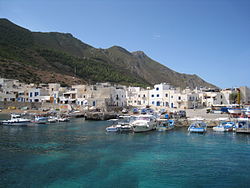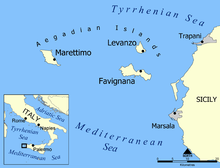| Revision as of 19:37, 21 June 2010 editSionix (talk | contribs)6 editsNo edit summary← Previous edit | Latest revision as of 22:25, 15 August 2024 edit undoRodRabelo7 (talk | contribs)Autopatrolled, Extended confirmed users, Page movers, Pending changes reviewers, Rollbackers111,652 editsm replacing {{IPA-it| → {{IPA|it| (deprecated template) | ||
| (70 intermediate revisions by 48 users not shown) | |||
| Line 1: | Line 1: | ||
| {{Infobox settlement | |||
| ⚫ | {{coord|37|58|10|N|12|03|26|E |
||
| | name = Marettimo | |||
| ⚫ | |||
| | native_name = <!-- If different from name --> | |||
| | native_name_lang = <!-- ISO 639-2 code e.g. "fr" for French. --> | |||
| | settlement_type = ] | |||
| | image_skyline = Marettimo-panorama.jpg | |||
| | image_alt = | |||
| | image_caption = Port of Marettimo | |||
| | pushpin_map = Italy | |||
| | pushpin_label_position = left | |||
| | pushpin_map_caption = Location in Italy | |||
| ⚫ | | coordinates = {{coord|37|58|10|N|12|03|26|E|display=inline,title}} | ||
| | subdivision_type = ] | |||
| | subdivision_name = {{flag|Italy}} | |||
| | subdivision_type1 = ] | |||
| | subdivision_name1 = ] | |||
| | subdivision_type2 = ] | |||
| | subdivision_name2 = ] | |||
| | established_title = | |||
| | established_date = | |||
| | seat_type = Municipality seat | |||
| | seat = | |||
| | unit_pref = Metric<!-- or US or UK --> | |||
| | area_footnotes = | |||
| | area_total_km2 = | |||
| | area_rank = | |||
| | area_note = | |||
| | elevation_footnotes = | |||
| | elevation_m = 686 | |||
| | elevation_max_m = | |||
| | population_footnotes = | |||
| | population_total = 300-700 | |||
| | population_as_of = | |||
| | population_rank = | |||
| | population_density_km2 = auto | |||
| | population_note = | |||
| | timezone = | |||
| | utc_offset = | |||
| | postal_code_type = | |||
| | postal_code = | |||
| | area_code_type = | |||
| | area_code = | |||
| | website = | |||
| | footnotes = | |||
| }} | |||
| ] | |||
| ⚫ | Marettimo is the second largest of the Aegadian Islands. The highest point is '' |
||
| ⚫ | '''Marettimo''' ({{IPA|it|maˈrettimo}};<ref>{{cite web|url=http://www.dipionline.it/dizionario/ricerca?lemma=Marettimo|title=Marettimo|work=DiPI Online|author=Luciano Canepari|author-link=Luciano Canepari|accessdate=17 January 2020|language=it}}</ref> ]: '''''Marrètimu''''') is one of the ] in the ] west of ], ]. It forms a part of the municipality ('']'') of ] in the ]. It takes about an hour to reach the island from ]. | ||
| ==History== | |||
| The ancient name of the island was "Hiera", perhaps a term of ] origin. | |||
| The ancient name of the island was '''Hiera''', part of the Greek name ''Hierà Nèsos'' (Ἱερά Νήσος), which means "Sacred Island" in Greek. Indeed, its Latin name used by ] was also "Sacra".<ref>, ''Il Giornale delle Egadi'', December 1998. Retrieved 20 May 2013.</ref> The name Marettimo probably comes from the words ''mar'' (sea) and ''timo'' (thyme) due to the profusion of thyme on the island. However, it may stem from a local pronunciation of the word "maritimo". | |||
| However, the name "Hiera" is part of the Greek name "Hiera Nesos", which means "Sacred Island" in Greek. | |||
| ⚫ | The island was an important observation point during Roman times, hence the Casa Romana, where it was easy to observe passing maritime traffic. The sea routes between Italy and North Africa and Italy and Spain (via Sardinia) would pass Marettimo. | ||
| The name Marettimo comes from the words Mar (Sea) and Timo (Thyme) due to the profusion of thyme on the island. | |||
| ] (1099–1165 or 1166), the Moroccan Muslim geographer, cartographer, Egyptologist and traveller who lived in Sicily at the court of King Roger II, mentioned this island, naming it جزيرة مليطمة (''jazīrat Malīṭma'', "the island of Malitma") on page 583 of his book ''Nuzhat al-mushtaq fi ihtiraq ghal afaq'', otherwise known as ], considered a geographic encyclopaedia of the medieval world. | |||
| ⚫ | The island was an important observation point during Roman times, hence the Casa Romana, where it was easy observe passing maritime traffic. The sea routes between Italy and North Africa and Italy and Spain (via Sardinia) would pass Marettimo. | ||
| There is a well restored Byzantine-Norman church adjacent to the Casa Romana. | There is a well restored Byzantine-Norman church adjacent to the Casa Romana. There are several impressive grottos around the island's coast and innumerable spots for excellent swimming in pristine waters on the western coast accessible only by boat. | ||
| ==Geography== | |||
| There are several impressive grottos around the islands coast and innumerable spots for excellent swimming in pristine waters. | |||
| ⚫ | Marettimo is the second largest of the Aegadian Islands. The highest point is ''Montefalcone'' with a height of {{convert|686|m|0|abbr=on}}. The island has about 300 inhabitants in the winter and 700 in the summer (not including tourists), who mainly live from fishing, tourism and traditional handcrafts. Fishing is predominantly conducted in the summer months. | ||
| ==Flora |
==Flora and fauna== | ||
| The island |
The island is home to about 500 plant species, many of them indigenous and very rare, among the most endangered being '']'', '']'', '']'' and '']'' subsp. ''nitidus''; the last was chemically investigated.<ref>Ammar Bader, Guido Flamini, Pier Luigi Cioni and Ivano Morelli, Journal of Essential Oils Research, Vol 13 pp.8-10</ref> | ||
| ⚫ | There is a sizeable population of donkeys and horses on the island. There are wild goats, rabbits, eagles, peregrine falcons and plenty of screeching gulls. | ||
| ==Fauna of Marettimo== | |||
| ⚫ | There is a sizeable |
||
| ==See also== | |||
| * ] | |||
| ==Gallery== | ==Gallery== | ||
| <gallery> | <gallery widths="105px" heights="130px"> | ||
| File:Marettimo2.jpg|The village of Marettimo | |||
| File:Marettimo3.jpg|Inside the village | |||
| Image:Spanish_Castle_on_Marettimo1.jpg|Moorish castle on the northern promontory. | |||
| File:Casa Romana1.jpg|The ruins of the "Casa Romana" settlement. | |||
| File:Town of Marettimo.jpg|From a ridge above town: Scalo Vecchio on the left, Scalo Nuovo on the right, and the Casa Romana in the left foreground. | |||
| File:Scoglio Cammello.jpg|Scoglio del Cammello | |||
| </gallery> | </gallery> | ||
| Line 31: | Line 80: | ||
| {{Reflist}} | {{Reflist}} | ||
| ==External links== | |||
| ⚫ | ] | ||
| * | |||
| {{Portal bar|Geography|Islands|Italy}} | |||
| {{Sicily-geo-stub}} | |||
| {{Aegadian Islands}} | |||
| {{Authority control}} | |||
| ⚫ | ] | ||
| ] | |||
| ] | |||
| ] | |||
| ] | |||
| ] | |||
| ] | |||
| ] | |||
| ] | |||
| ] | |||
| ] | |||
| ] | |||
| ] | |||
| ] | |||
| ] | |||
| ] | |||
| ] | |||
| ] | |||
Latest revision as of 22:25, 15 August 2024
Island in Trapani, Italy| Marettimo | |
|---|---|
| Island | |
 Port of Marettimo Port of Marettimo | |
 | |
| Coordinates: 37°58′10″N 12°03′26″E / 37.96944°N 12.05722°E / 37.96944; 12.05722 | |
| Country | |
| Province | Trapani |
| Comune | Favignana |
| Elevation | 686 m (2,251 ft) |
| Population | |
| • Total | 300−700 |

Marettimo (Italian pronunciation: [maˈrettimo]; Sicilian: Marrètimu) is one of the Aegadian Islands in the Mediterranean Sea west of Sicily, Italy. It forms a part of the municipality (comune) of Favignana in the Province of Trapani. It takes about an hour to reach the island from Trapani.
History
The ancient name of the island was Hiera, part of the Greek name Hierà Nèsos (Ἱερά Νήσος), which means "Sacred Island" in Greek. Indeed, its Latin name used by Pliny was also "Sacra". The name Marettimo probably comes from the words mar (sea) and timo (thyme) due to the profusion of thyme on the island. However, it may stem from a local pronunciation of the word "maritimo".
The island was an important observation point during Roman times, hence the Casa Romana, where it was easy to observe passing maritime traffic. The sea routes between Italy and North Africa and Italy and Spain (via Sardinia) would pass Marettimo.
Abu Abd Allah Muhammad al-Idrisi (1099–1165 or 1166), the Moroccan Muslim geographer, cartographer, Egyptologist and traveller who lived in Sicily at the court of King Roger II, mentioned this island, naming it جزيرة مليطمة (jazīrat Malīṭma, "the island of Malitma") on page 583 of his book Nuzhat al-mushtaq fi ihtiraq ghal afaq, otherwise known as The Book of Roger, considered a geographic encyclopaedia of the medieval world.
There is a well restored Byzantine-Norman church adjacent to the Casa Romana. There are several impressive grottos around the island's coast and innumerable spots for excellent swimming in pristine waters on the western coast accessible only by boat.
Geography
Marettimo is the second largest of the Aegadian Islands. The highest point is Montefalcone with a height of 686 m (2,251 ft). The island has about 300 inhabitants in the winter and 700 in the summer (not including tourists), who mainly live from fishing, tourism and traditional handcrafts. Fishing is predominantly conducted in the summer months.
Flora and fauna
The island is home to about 500 plant species, many of them indigenous and very rare, among the most endangered being Bupleurum dianthifolium, Brassica macrocarpa, Scilla hughii and Thymus richardii subsp. nitidus; the last was chemically investigated.
There is a sizeable population of donkeys and horses on the island. There are wild goats, rabbits, eagles, peregrine falcons and plenty of screeching gulls.
See also
Gallery
-
 The village of Marettimo
The village of Marettimo
-
 Inside the village
Inside the village
-
 The ruins of the "Casa Romana" settlement.
The ruins of the "Casa Romana" settlement.
-
 From a ridge above town: Scalo Vecchio on the left, Scalo Nuovo on the right, and the Casa Romana in the left foreground.
From a ridge above town: Scalo Vecchio on the left, Scalo Nuovo on the right, and the Casa Romana in the left foreground.
-
 Scoglio del Cammello
Scoglio del Cammello
References
- Luciano Canepari. "Marettimo". DiPI Online (in Italian). Retrieved 17 January 2020.
- "Frammenti per la Storia dell'Isola di Marettimo", Il Giornale delle Egadi, December 1998. Retrieved 20 May 2013.
- Ammar Bader, Guido Flamini, Pier Luigi Cioni and Ivano Morelli, Journal of Essential Oils Research, Vol 13 pp.8-10
External links
Portals:| Aegadian Islands | |
|---|---|